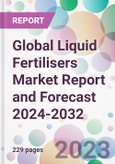According to the report, the global liquid fertilisers market is projected to grow at a CAGR of 4.4% between 2024 and 2032 reaching a value of approximate USD 4.08 billion by 2032. Aided by the rising need for efficient crop nutrition methods and the benefits of liquid fertilisers in precision farming, the market is expected to grow significantly by 2032.
Liquid fertilisers, as the name suggests, are nutrient-rich fluids applied to plants and soil to promote crop growth and enhance crop yield. Their easy-to-apply nature and ability to provide direct nutrition to plants have made them a preferred choice amongst modern farmers. These fertilisers can be used in various agricultural practices, ranging from foliar applications to fertigation systems. They ensure that crops receive balanced nutrition, which is essential for their growth and health.
One of the primary driving forces behind the liquid fertilisers market growth is the increasing demand for high-yield crops across the world. With the global population on the rise, there's an augmented pressure on the agricultural sector to meet the food demands. Liquid fertilisers, due to their rapid absorption rate and efficacy, help farmers achieve this by ensuring that crops receive precise nutrition.
Moreover, technological advancements in farming, especially the emergence of precision agriculture, have accentuated the liquid fertilisers market demand. Precision farming relies on accurate data and analytics to ensure optimal crop growth. Liquid fertilisers fit seamlessly into this narrative as they allow for easy dosage control and uniform application, thus enhancing the efficacy of precision farming techniques.
Another significant factor promoting the growth of liquid fertilisers is the awareness of sustainable farming practices. As per the liquid fertilisers market analysis, over-reliance on traditional chemical fertilisers has led to soil degradation and environmental issues. Liquid fertilisers, particularly organic variants, offer a more environmentally friendly solution to the farmers. They ensure that the soil retains its natural nutrient balance, leading to sustainable and prolonged agricultural productivity.
In the industrial sphere, there's an increasing trend towards the development and commercialisation of bio-based liquid fertilisers which further increases the value of the liquid fertilisers market size. These fertilisers are derived from natural sources, and their application doesn't harm the environment.
Liquid fertilisers, as the name suggests, are nutrient-rich fluids applied to plants and soil to promote crop growth and enhance crop yield. Their easy-to-apply nature and ability to provide direct nutrition to plants have made them a preferred choice amongst modern farmers. These fertilisers can be used in various agricultural practices, ranging from foliar applications to fertigation systems. They ensure that crops receive balanced nutrition, which is essential for their growth and health.
One of the primary driving forces behind the liquid fertilisers market growth is the increasing demand for high-yield crops across the world. With the global population on the rise, there's an augmented pressure on the agricultural sector to meet the food demands. Liquid fertilisers, due to their rapid absorption rate and efficacy, help farmers achieve this by ensuring that crops receive precise nutrition.
Moreover, technological advancements in farming, especially the emergence of precision agriculture, have accentuated the liquid fertilisers market demand. Precision farming relies on accurate data and analytics to ensure optimal crop growth. Liquid fertilisers fit seamlessly into this narrative as they allow for easy dosage control and uniform application, thus enhancing the efficacy of precision farming techniques.
Another significant factor promoting the growth of liquid fertilisers is the awareness of sustainable farming practices. As per the liquid fertilisers market analysis, over-reliance on traditional chemical fertilisers has led to soil degradation and environmental issues. Liquid fertilisers, particularly organic variants, offer a more environmentally friendly solution to the farmers. They ensure that the soil retains its natural nutrient balance, leading to sustainable and prolonged agricultural productivity.
In the industrial sphere, there's an increasing trend towards the development and commercialisation of bio-based liquid fertilisers which further increases the value of the liquid fertilisers market size. These fertilisers are derived from natural sources, and their application doesn't harm the environment.
Market Segmentation
The market can be divided based on type, form, mode of application, crop type, and region.Market Breakup by Type
- Nitrogen
- Potassium
- Phosphate
- Micronutrients
Market Breakup by Form
- Organic
- Synthetic
Market Breakup by Mode of Application
- Foliar
- Aerial
- Starter solutions
- Fertigation
- Injection into Soil
Market Breakup by Crop Type
- Grains and Cereals
- Pulses and Oilseeds
- Fruits and Vegetables
- Commercial Crops
- Others
Market Breakup by Region
- North America
- Europe
- Asia Pacific
- Latin America
- Middle East and Africa
Competitive Landscape
The report looks into the market shares, plant turnarounds, capacities, investments, and mergers and acquisitions, among other major developments, of the leading companies operating in the global liquid fertilisers market. Some of the major players explored in the report are as follows:- Yara International ASA
- Israel Chemical Ltd. (ICL)
- Sociedad Química Y Minera De Chile (SQM)
- Kugler Company
- Agroliquid
- Haifa Chemicals Ltd.
- Agrium Inc.
- Compo Expert GmbH
- Plant Food Company, Inc
- Others
Table of Contents
1 Preface2 Report Coverage - Key Segmentation and Scope4 Key Assumptions7 Opportunities and Challenges in the Market15 Value Chain Analysis16 Price Analysis18 Key Trends and Developments in the Market
3 Report Description
5 Executive Summary
6 Snapshot
8 Global Liquid Fertilisers Market Analysis
9 North America Liquid Fertilisers Market Analysis
10 Europe Liquid Fertilisers Market Analysis
11 Asia Pacific Liquid Fertilisers Market Analysis
12 Latin America Liquid Fertilisers Market Analysis
13 Middle East and Africa Liquid Fertilisers Market Analysis
14 Market Dynamics
17 Competitive Landscape
List of Key Figures and Tables
Companies Mentioned
- Yara International ASA
- Israel Chemical Ltd. (ICL)
- Sociedad Química Y Minera De Chile (SQM)
- Kugler Company
- Haifa Chemicals Ltd.
- Compo Expert GmbH
- Agroliquid
- Agrium Inc.
- Plant Food Company Inc
Methodology

LOADING...








